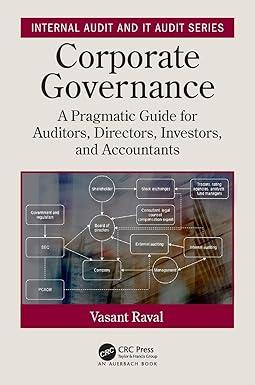Question
The group project is a hands-on exercise in planning a financial statement audit. The project will give you an opportunity to consider how the concepts
The group project is a hands-on exercise in planning a financial statement audit. The project will give you an opportunity to consider how the concepts and techniques discussed in the course apply in auditing an actual business. Your team will take on the role of the audit engagement team for a publicly-traded Canadian company. Assume that your audit firm has already conducted its client retention procedures (this is not the first year that you are auditors), independence analysis, and has determined that the members of your team are the best people for the job. Now that has been done, your team is required to develop the client risk profile and plan the audit of the client company (with a focus on the revenue cycle) for its upcoming year-end. Your team is expected to provide two deliverables (more details on each part are provided below): Description Allocation Session Due Part 1 Client Risk Profile Assess Client Business Risk 5 March 25 Part 2 Client Risk Profile Preliminary Analytical Review & Implications to Audit, Audit Risk, Materiality 5 March 25 Total 10 You are expected to use the companys most recent quarterly results, the most recent annual report, and other publicly-available information. State any assumptions you find it necessary to make. You should not contact the organization or interview people for this project. You should not contact the actual auditors as they will need to keep all the client information confidential. Please feel free to ask the instructor for further guidance if any of the requirements are not clear. Part 1 Client Risk Profile Assess Client Business Risk (limit of 3-4 pages (single space), including appendices) The aim of this part of your assignment is to prepare a detailed industry and business risk analysis for the company you have been assigned: In preparing the analysis, be sure to include the following: Business strategies Key competitors Industry Trends Key Business Processes Financial Resources and Availability Major Risks In your analysis, you need to make a conclusion on the companys risk. 2 You are expected to perform a thorough search, using a variety of electronic sources such as: The companys annual report (ensure you look at managements discussion and analysis along with the financial statements) The companys website Stock broker or investment analyses Business press Professional Journals (such as CPA Magazine) CPA Handbook Assurance and Accounting Standards CPA Risk Alerts * Note You may find that the industry guides prepared by many of the Big Four Firms (PWC, Deloitte, KPMG, and E&Y) to be useful for your industry. Remember to prepare a bibliography and use proper citation Part 2 Preliminary Analytical Review & Implications for the Audit (limit of 3-4 pages, not including appendices) Preliminary Analytical Review In this part of your assignment, you are expected to conduct an analytical analysis of your company that includes: (1) common-size financial statements for the past three years (you will need to decide what expectations you have regarding the interim statements for your company) and (2) financial ratios that are commonly used for that particular industry Your financial ratio analysis should include: (1) a three-year ratio comparison by year (for the company), relevant comparisons to (2) industry and (3) a relevant competitor. Categories (more details on the various categories have been posted to the course website in Assignments folder) for your ratios should be: Stock valuation Growth Financial Strength Profitability Management Effectiveness Efficiency All of the above ratios should be presented in an appendix (2-page max). Your analysis should comment on the expectations that you have developed (based on part I) and what account balances warrant further concern/attention in terms of audit planning. You should not comment on all ratios and changes. Only on changes that warrant further attention. Please ensure you relate your concerns to management assertions for the particular accounts. Inherent Risk In this report you need to include a discussion of what your conclusions in your business risk analysis and your analytical analysis means for the conduct of the audit. In 3 particular, you should discuss what accounts/cycles you feel are high inherent risk and which are at lower levels of risk. In making these decisions, you should consider factors such as unusual or unexpected fluctuations, audit complexity (points to consider is it an estimate with a lot of subjectivity?), and risk of material misstatement due to management bias. Refer to your textbook and Audit Standards for further guidance. As in Part 1, you are expected to perform a thorough search, using a variety of electronic sources. This is necessary in order to obtain explanations for fluctuations, deviations, etc Audit risk Now that you have familiarized yourself with your client, you should have enough information to set audit risk (based upon your assessment of engagement risk). Ensure that you consider the relevant factors that would heighten the risk of the engagement to the auditor (refer to your textbook, audit standards, and slides regarding how to set audit risk). Materiality Once you have set audit risk, another important decision is determination of materiality. In order to determine materiality, you should refer to the Audit Standards, the textbook, as well as materials posted to the course website, and any other relevant professional materials.
Step by Step Solution
There are 3 Steps involved in it
Step: 1

Get Instant Access to Expert-Tailored Solutions
See step-by-step solutions with expert insights and AI powered tools for academic success
Step: 2

Step: 3

Ace Your Homework with AI
Get the answers you need in no time with our AI-driven, step-by-step assistance
Get Started


